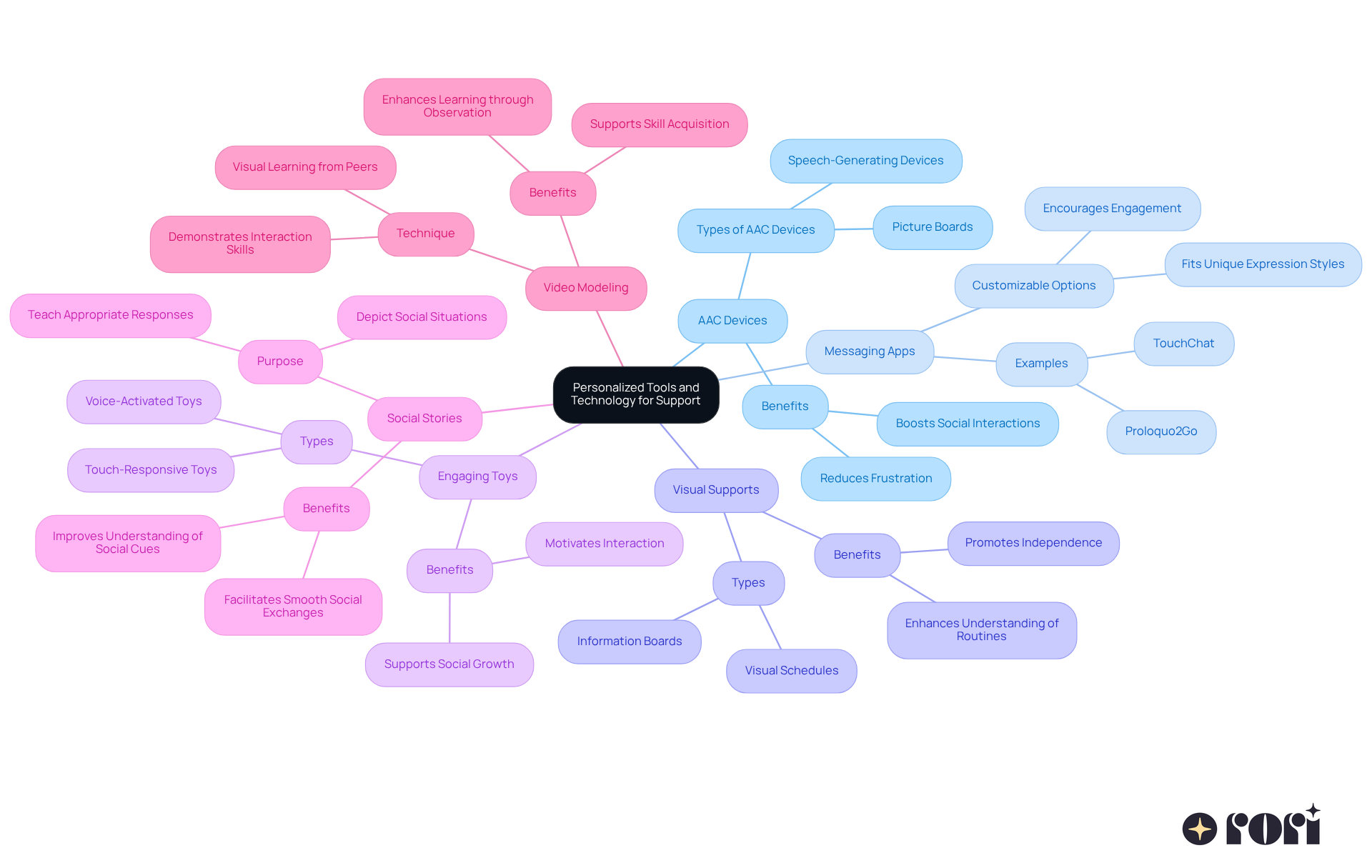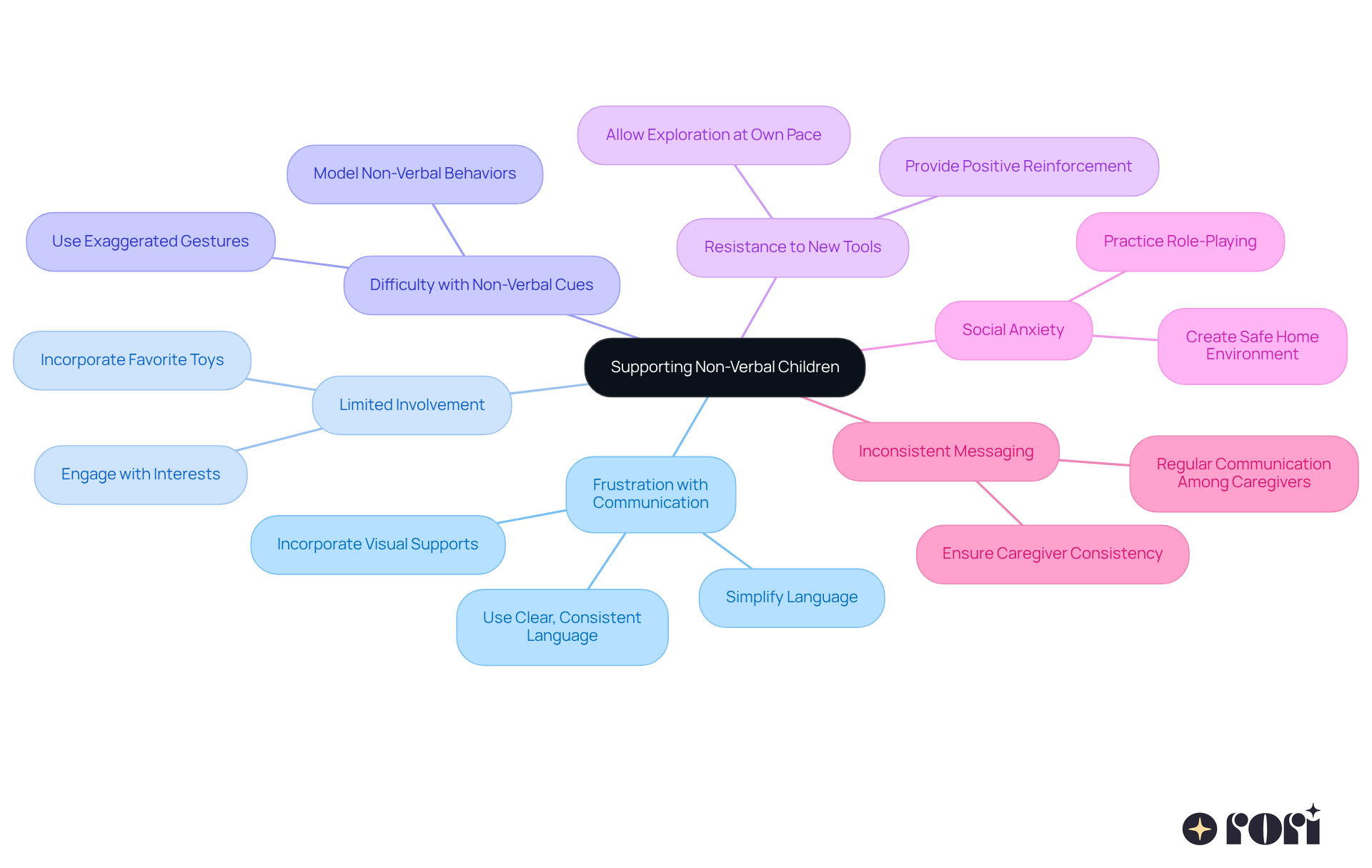Supporting a non-verbal child can feel overwhelming at times, but you’re not alone! Here are four essential strategies that can make a real difference.
Understanding non-verbal communication cues:
Recognizing gestures and expressions is key to connecting with your child. It’s amazing how much they can express without words!
Implementing effective communication strategies:
Using visual supports, like pictures or symbols, can help your child convey their needs and feelings. And don’t forget about technology! Tools like AAC devices can be game-changers, opening up new avenues for communication.
Personalized tools:
Every child is unique, so finding what works best for your little one is important. Whether it’s a specific app or a favorite toy that helps them express themselves, these tools can create a nurturing environment.
Troubleshooting common issues:
Of course, there will be challenges along the way. Remember, it’s all about patience and persistence. By creating a supportive atmosphere, you’re encouraging effective communication and addressing your child’s unique needs.
Let’s explore this together! Share your experiences or ask questions in the comments below. We’re here to help you every step of the way!
Understanding and supporting children who are non-verbal can be quite the journey, filled with unique challenges and those rewarding breakthroughs we all cherish. By using effective strategies and insights into non-verbal communication, caregivers can create a nurturing environment that truly fosters expression and connection. But what happens when traditional methods just don’t cut it, and frustration starts to creep in?
This article dives into essential strategies that empower caregivers to bridge those communication gaps. Let’s transform those challenges into opportunities for meaningful interaction! Together, we can explore this journey and find ways to connect more deeply with our little ones.
Non-verbal interaction is all about those little behaviors that send messages without a single word being spoken. For kids on the autism spectrum, these cues are super important! By understanding and using non-verbal signals, you can really boost their communication skills.
By recognizing and understanding these unspoken cues, you can create a more supportive environment that meets your child’s unique needs. Let’s explore this together!

To help my child who is non verbal communicate better, let’s explore some friendly strategies that can really make a difference. These tips align with the principles of Applied Behavior Analysis (ABA) and can be even more effective when caregivers are educated about them.
Use Simple Language: Start with single words or short phrases that are easy for your little one to grasp. For instance, instead of saying, "Can you pass me the ball?" just say, "Ball." This straightforward approach fits perfectly with ABA's focus on clear communication.
Incorporate Visual Supports: Pictures, symbols, or objects can be great tools to represent words or concepts. Research shows that visual aids can significantly boost interaction by helping kids connect visual cues with spoken language. Think about using visual schedules or choice boards—they can help your child anticipate activities and express their needs more clearly, reinforcing the consistency that ABA emphasizes.
Encourage Imitation: Engage in fun activities that promote imitation, like playing games where you mimic each other’s actions or sounds. This can help your child learn to express themselves through gestures and sounds, which are key for social interaction and communication skills—important parts of early intensive behavioral intervention (EIBI).
Create Opportunities for Choice: Give your child options throughout the day, like choosing between two toys or snacks. This encourages them to communicate their preferences, whether through gestures or sounds, and fosters independence. Specialists say that offering choices can empower kids and boost their engagement, aligning with the goals of caregiver involvement in ABA.
Be Patient and Give Time: Allow your child enough time to respond during conversations. This patience can ease anxiety and encourage them to express themselves at their own pace, which is crucial for building confidence in communication. Remember, my child is non verbal and often needs extra time to process interactions, so being aware of this is vital for caregivers.
Utilize Play as a Means of Interaction: Make play a part of your communication efforts. Activities like role-playing or using toys can create a fun environment for your child to practice their communication skills, making learning enjoyable and effective. Engaging in activities they love builds trust and encourages participation, reinforcing your role in supporting their development.
By putting these strategies into practice, you can create a nurturing environment that encourages your child to communicate more effectively. Leverage their strengths and interests while empowering yourself with the knowledge and skills gained through caregiver education. Together, we can enhance informed decision-making and lead to better behavioral outcomes!

Integrating customized tools and technology can really help young individuals express themselves better. Let’s explore some effective options together:
Augmentative and Alternative Communication (AAC) Devices: These range from simple picture boards to advanced speech-generating devices. They allow young individuals to share their needs and ideas through symbols or text. Studies show that AAC can reduce frustration and boost social interactions, making it a vital tool for my child who is non verbal.
Messaging Apps: Check out apps designed for non-verbal communication, like Proloquo2Go and TouchChat. These apps often offer customizable options that fit the unique way my child is non verbal in expressing themselves, encouraging engagement and articulation. More families are turning to these tools to enhance their interactions.
Visual Supports: Think about creating visual schedules or information boards that outline daily activities or choices. This approach helps kids understand their routines and express their preferences, promoting independence and clearer communication.
Engaging Toys: Look for toys that encourage interaction, like those that respond to touch or voice. These toys can motivate your little one to engage and develop their interaction skills, which is great for their social growth.
Social Stories: Craft social stories that depict different social situations and appropriate responses. These stories can help your child grasp social cues and improve their ability to share ideas in various contexts, making social exchanges smoother.
Video Modeling: Use video modeling techniques to demonstrate interaction skills. Watching clips of peers or adults using communication strategies provides your child with a visual example to learn from, enhancing their learning through observation.
By using these customized tools and technologies, you can significantly boost communication skills for children, especially for those like my child who is non verbal, and provide the essential support they need to thrive. We’re here to help you every step of the way!

Helping kids like my child who is non verbal can be quite the journey, right? But with the right strategies, we can really boost their communication skills. Let’s dive into some common challenges and how we can tackle them together:
Frustration with Communication: It’s tough when our little ones struggle to express themselves. This can lead to frustration for both them and us. Using clear, consistent language along with visual supports can really help. Simplifying our language can make a world of difference!
Limited Involvement: If your child seems a bit uninterested, try weaving their favorite toys or topics into your interactions. When they see something they love, it can spark their interest and make conversations a lot more fun!
Difficulty with Non-Verbal Cues: To help your child understand non-verbal signals, it’s super helpful to model these behaviors consistently. Exaggerated gestures and facial expressions can really reinforce your messages, making it easier for them to catch on.
Resistance to New Tools: If your child is hesitant about using new communication tools, take it slow. Let them explore at their own pace and offer plenty of positive reinforcement when they engage with these tools. This can help them feel more comfortable and familiar.
Social Anxiety: For those little ones who feel anxious in social situations, practicing at home can be a game-changer. Role-playing different interactions can help them feel more prepared and confident when it’s time to engage with others.
Inconsistent Messaging: It’s crucial that all caregivers are on the same page with messaging strategies. Consistency is key in helping your child express themselves, making them feel safe and understood.
By addressing these challenges head-on, we can create a nurturing environment that enhances communication for my child who is non verbal. Let’s explore this together! We’re here to help you every step of the way!

Supporting a non-verbal child can feel like a big challenge, but it’s all about understanding their unique communication needs and finding the right strategies. By tuning into non-verbal cues, caregivers can create a warm environment that encourages expression and connection. Recognizing gestures, facial expressions, body language, and eye contact can really boost communication efforts.
There are some great strategies to consider!
It’s also important to address common challenges, such as frustration and social anxiety, with patience and consistency to create a supportive atmosphere.
Ultimately, supporting a non-verbal child is a journey of collaboration and understanding. By embracing these strategies and tools, caregivers can enhance their child’s communication skills while building a stronger bond and fostering independence. Staying proactive and patient is key—continuously adapting to your child’s needs can lead to amazing advancements in their ability to connect with the world around them.
Let’s explore this together! Remember, you’re not alone in this journey. We’re here to help you every step of the way!
What is non-verbal communication in children?
Non-verbal communication involves behaviors that send messages without spoken words, including gestures, facial expressions, body language, and eye contact.
Why is non-verbal communication important for children on the autism spectrum?
For children on the autism spectrum, non-verbal cues are crucial for expressing their needs and wants, thereby enhancing their communication skills.
What types of gestures should I look for in my child?
You should pay attention to gestures such as pointing or nodding, as these actions often indicate what your child needs or wants.
How can facial expressions convey messages?
Facial expressions can provide insights into a child's feelings; for example, a smile may indicate happiness, while a frown could suggest confusion or frustration.
What does body language indicate about a child's feelings?
Open body language often suggests comfort, while crossed arms may indicate that a child is feeling defensive or uneasy.
Why is eye contact important in communication?
Encouraging eye contact is important as it fosters connection and shows that the child is engaged in the conversation.
How can I model silent communication for my child?
You can model silent communication by incorporating your own gestures and facial expressions to complement your spoken words, helping your child to understand better.
How can understanding non-verbal cues create a supportive environment?
By recognizing and understanding non-verbal cues, you can create a more supportive environment that caters to your child's unique communication needs.